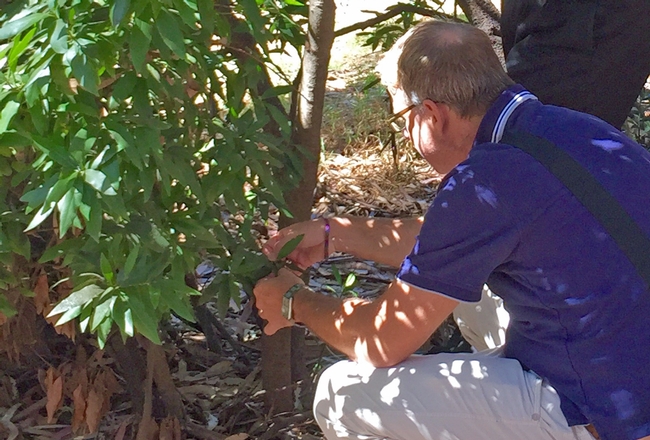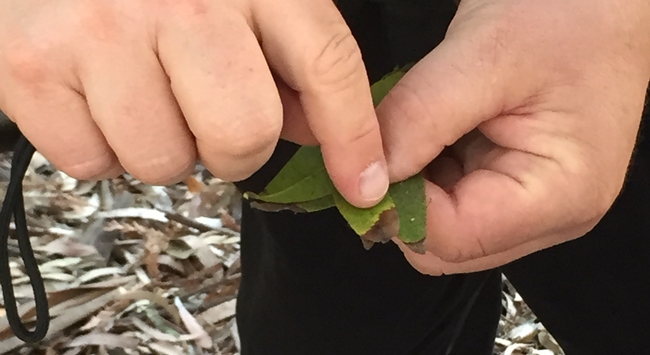Citizen science SOD Blitz starts April 11 with new COVID-19 safety measures
With Californians sheltering in place to stop the spread of new coronavirus COVID-19, the annual citizen science project to map sudden oak death disease has been redesigned to ensure the safety of participants. The first in a series of SOD blitzes of 2020 will be April 11 in Napa. The events are free.
“We have been able to redesign the 2020 SOD Blitzes to make them a safe and legal activity that allows volunteers to exercise outdoors, and this powerful citizen science program will help us protect our forests' health,” said Matteo Garbelotto, UC Cooperative Extension forest pathology specialist and adjunct professor in the Department of Environmental Science, Policy and Management at UC Berkeley and event organizer.
Sudden oak death disease has killed more than 50 million of the state's iconic oaks and tanoak trees between Humboldt County and Monterey County, threatening survival of several tree species. In 2019 alone, 1 million tanoaks succumbed to sudden oak death, according to 2019 tree mortality data released by the U.S. Forest Service.
“The presence of new SOD strains is alarming and the SOD blitzes are the best, if not the only, program to intercept them before they spread,” Garbelotto said.
SOD Blitz volunteers will register online and take the training online at www.sodblitz.org to learn how to identify SOD symptoms and to carefully collect symptomatic leaves from California bay laurels and tanoaks. Collection and survey materials, which have been prepared in a sterile environment, will be picked up by participants at a local SOD Blitz station conveniently located near a parking lot. They can return samples to the same SOD Blitz station or by mail.
As citizen scientists, volunteers should focus on following safety guidance as well as adhering to research protocols. Social distancing – at least 6 feet away from other volunteers – and clean “housekeeping” rules will be strongly enforced when picking up or returning materials and during leaf collection.
For parents who are home schooling their children, this is an activity that the family can do together.
Garbelotto encourages tree care specialists to participate in the SOD blitzes.
“Besides offering free bay laurel and tanoak tests for their clients, we now offer tree care professionals free enrollment in UC Berkeley Forest Pathology Laboratory's OakSTePprogram, which allows them to test oaks for SOD infection,” Garbelotto said.
For more information, visit www.treefaqs.org or email the organizer of the SOD Blitz in your community (See schedule below).
Sudden Oak Death Blitzes 2020
All collection materials will be provided, but participants need a mobile phone or GPS device to install the free SODmap mobile app.
New format due to COVID-19
1. Training (30 minutes) and sign-up (5 minutes) must be done online at www.sodblitz.org before collecting the sampling materials at the SOD Blitz Stations in the locations specified below. Please sign up before you start the survey, and preferably when you take the online training.
2. Once at your local SOD Blitz Station you can pick up one or two collection packets following the social distancing rules of the State of California clearly specified in the online training. Stay at least 6 feet from other collectors. Bring your own pencil. Each packet allows you to sample 10 trees. Do not pick more unless you discussed it with the organizer.
3. Before you start the survey, make sure you have downloaded the free App “SODmap mobile” to determine the exact location of the trees you sample.
4. Each SOD Blitz has a start and end date, including the hour. You can pick up materials at the start time and you have to return your samples and any unused collection materials by the end date and cutoff time.
5. You can sample private properties with the owner's permission, alongside public roads and in parks or open spaces that are open to the public.
6. If you have any questions, please email your local organizer. Thank you so much for your participation.
Napa Blitz
Saturday, April 11 at 10 a.m. to Tuesday, April 14, 10 a.m.
SOD Blitz Station located on front porch of the Napa County Agriculture Commissioners Office Building 1710 Soscol, Napa
Please mail samples to UC Berkeley using the preprinted mail labels and postage included in each packet.
Contact: Bill Pramuk info@billpramuk.com
For a schedule of SOD Blitzes at other locations, visit https://nature.berkeley.edu/matteolab/?page_id=5095.



